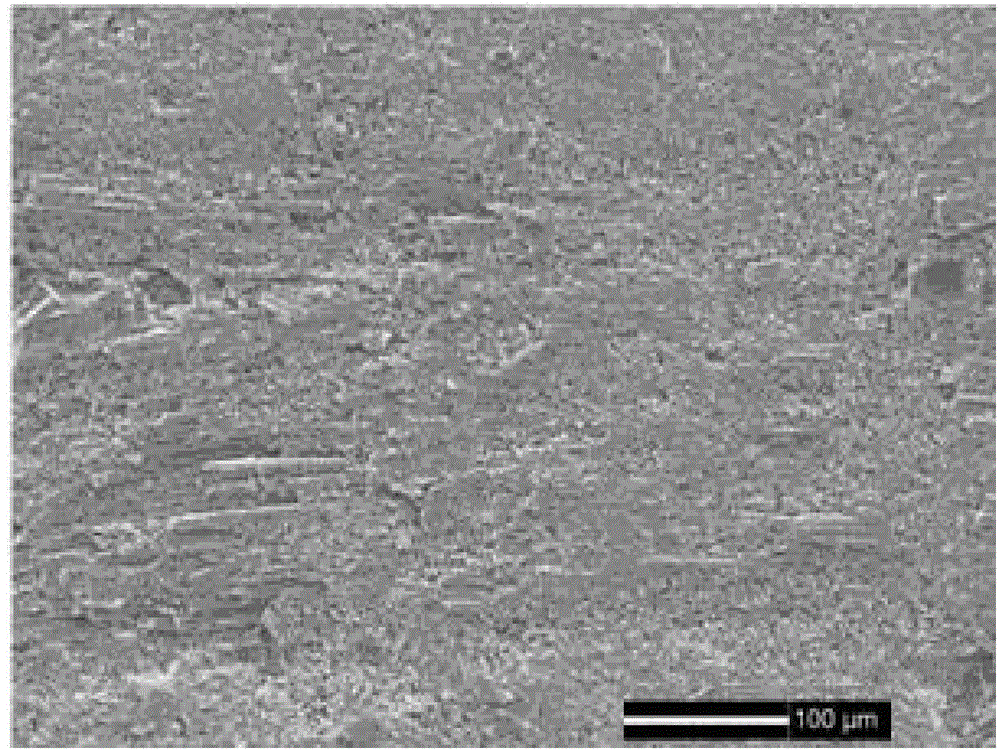Ceramic matrix composite material employing silicon alkyne-modified SiBCN as precursor and preparation method of ceramic matrix composite material
A composite material and precursor technology, applied in the field of ceramic materials, can solve the problem of less crosslinkable functional groups, and achieve the effects of good compactness, improved compactness, and excellent high-temperature oxidation resistance.
- Summary
- Abstract
- Description
- Claims
- Application Information
AI Technical Summary
Problems solved by technology
Method used
Image
Examples
Embodiment 1
[0024] (1) Using three-way orthogonal structure T300 carbon fiber fabric as a reinforcement, make a 100mm×100mm flat plate sample, and the fabric fiber volume fraction is 40%.
[0025] (2) Under the protection of nitrogen gas flow, first add 500g of SiBCN precursor to a three-necked flask, then add 500ml of toluene, stir to dissolve, then add 500g of polysiliconacetylene, stir at room temperature for 2 hours, remove the solvent under reduced pressure, and continue at 70°C After stirring for 1 hour, a deep red viscous impregnation solution was obtained.
[0026] (3) Introducing the impregnation solution obtained in step (2) into the fabric prepared in step (1) by vacuum impregnation. At 60°C and a pressure of 0.2MPa, impregnate the impregnating liquid into the fabric for 2 hours. After the impregnation is complete, take out the green body and put it into a curing tank at a temperature of 60°C, and then heat it at 200°C. The temperature and the pressure of 3MPa are pressurized ...
Embodiment 2
[0034] (1) Using the three-way orthogonal structure T700 carbon fiber fabric as a reinforcement, a 100mm×100mm flat plate sample is made, and the fabric fiber volume fraction is 45%.
[0035] (2) Under the protection of nitrogen gas flow, first add 500g of SiBCN precursor to a three-necked flask, then add 500ml of toluene, stir to dissolve, then add 500g of polysiliconacetylene, stir at room temperature for 2 hours, remove the solvent under reduced pressure, and continue at 70°C After stirring for 1 hour, a deep red viscous impregnation solution was obtained.
[0036] (3) Introducing the dipping solution prepared in step (2) into the fabric prepared in step (1) by vacuum impregnation. At 60°C and a pressure of 0.2MPa, impregnate the impregnating liquid into the fabric for 2 hours. After the impregnation is complete, take out the green body and put it into a curing tank (60°C); at a temperature of 200°C and Pressure curing is carried out under 3 MPa pressure, the curing time i...
Embodiment 3
[0043] (1) Using the three-way orthogonal structure T300 carbon fiber fabric as a reinforcement, make a 100mm×100mm flat plate sample.
[0044] (2) Under the protection of nitrogen gas flow, first add 100g of SiBCN precursor to a three-necked flask, then add 500ml of toluene, stir to dissolve, then add 900g of polysiliconacetylene, stir at room temperature for 2 hours, remove the solvent under reduced pressure, and continue at 70°C After stirring for 1 hour, a deep red viscous impregnation solution was obtained.
[0045](3) Introducing the dipping solution prepared in step (2) into the fabric prepared in step (1) by vacuum impregnation. At 60°C and a pressure of 0.2MPa, impregnate the impregnating liquid into the fabric for 2 hours. After the impregnation is complete, take out the green body and put it into a curing tank (60°C); at a temperature of 200°C and Pressure curing is carried out under 3 MPa pressure, the curing time is 8 hours, and the temperature is slowly lowered ...
PUM
| Property | Measurement | Unit |
|---|---|---|
| density | aaaaa | aaaaa |
| strength | aaaaa | aaaaa |
| bending strength | aaaaa | aaaaa |
Abstract
Description
Claims
Application Information
 Login to View More
Login to View More - R&D
- Intellectual Property
- Life Sciences
- Materials
- Tech Scout
- Unparalleled Data Quality
- Higher Quality Content
- 60% Fewer Hallucinations
Browse by: Latest US Patents, China's latest patents, Technical Efficacy Thesaurus, Application Domain, Technology Topic, Popular Technical Reports.
© 2025 PatSnap. All rights reserved.Legal|Privacy policy|Modern Slavery Act Transparency Statement|Sitemap|About US| Contact US: help@patsnap.com


